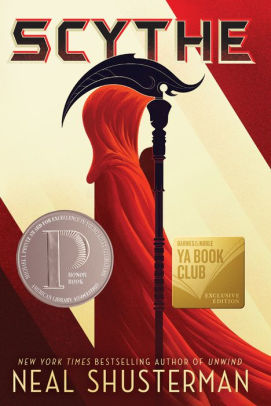By Neal Shusterman
Read in 8th grade
Book 1 in series
Read book 2! Thunderhead (coming soon)
Read book 3! The Toll
First book in Arc of a Scythe series. It takes place in a world past death, without disease or aging. Pain nanites can regrow limbs, and if you are killed in an accident, you are revived. There is no politics, because the world is taken care of by an AI called the Thunderhead. It keeps the world running, and every move is calculated so it is never wrong. Its mission: Protect humanity. At all costs. So how is the population kept in check if no one dies? Scythedom. This group is beholden to no laws, and the Thunderhead must stay out of its way as a part of its fundamental programming. These people go around and glean people, and can also grant immunity for a year. They can take whatever they want, and everyone fears/respects them.
One day, Scythe Faraday shows up at Citra Terranova's house and eats a meal. Afterward, he asks for a knife. Her family is terrified, but he gleans the person next door and grants Citra's mother immunity. Rowan Damisch is sitting at his friend Tyger's bedside after he splatted from hundreds of feet up. At school, Faraday shows up to glean the high school quarterback. Rowan stays with him for emotional support. Faraday notes his compassion. Later, he is ridiculed, accused of being with the quarterback for immunity.
